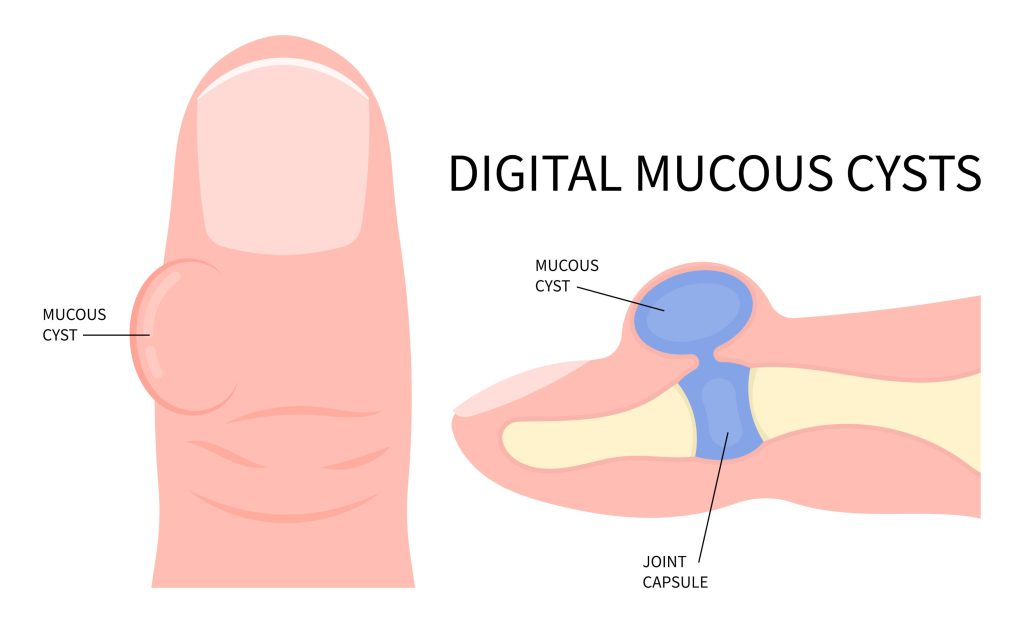What is a Mucous Cyst?

A mucous cyst is a small, fluid-filled sac that typically forms on the back of the finger, near the base of the fingernail. It is a type of ganglion cyst that arises from the capsule of the distal interphalangeal joint (DIP), the joint at the tip of the finger. The cyst is connected to the joint capsule by a narrow “stalk,” which allows synovial fluid from the joint to fill the cyst.
Mucous cysts are most commonly found on the index and middle fingers and are often associated with osteoarthritis of the affected joint. While they may be painless, mucous cysts can lead to nail deformities, mild tenderness, or cosmetic concerns, and sometimes interfere with normal finger function.
Types of Mucous Cysts
Mucous cysts can be classified based on their location and relationship to the joint:
- Dorsal Mucous Cysts
- Form on the back of the finger near the nail.
- The most common type, often linked with osteoarthritis.
- May cause nail changes if left untreated.
- Volar Mucous Cysts
- Develop on the palm side of the finger, near the distal joint.
- Less common, and surgical treatment can be more complex due to nearby tendons and nerves.
- Juxta-Articular Cysts
- Form adjacent to the joint capsule, sometimes extending toward the fingertip or nail.
- Associated with degenerative changes in the joint.
- Digital Mucous Cysts (Digital Myxoid Cysts)
- Found on fingers or toes, usually at the DIP joint near the nail.
- Connected to the joint capsule via a small stalk, allowing synovial fluid to enter.
- Can cause visible bumps, tenderness, nail deformities, or occasional fluid leakage.
Causes of Mucous Cysts
Mucous cysts are most commonly caused by degenerative changes in the finger joint. Other contributing factors include:
- Osteoarthritis – The most common cause, leading to joint degeneration and cyst formation.
- Repetitive stress or trauma – Frequent use or minor injuries to the fingertip can contribute.
- Joint degeneration over time – Wear-and-tear in the DIP joint makes fluid leakage more likely.
How Are Mucous Cysts Diagnosed?
Diagnosis typically begins with a physical examination. Your physician will inspect the cyst, evaluate finger movement, and check for tenderness or nail changes.
Imaging tests, such as X-rays, are often recommended because mucous cysts are commonly linked with arthritic changes in the DIP joint. X-rays help determine the extent of joint degeneration and guide treatment decisions.
How Are Mucous Cysts Treated?
Treatment depends on the size of the cyst, symptoms, and impact on finger function:
Conservative Management
- Observation: Small, asymptomatic cysts may be monitored over time.
- Aspiration: Draining the cyst fluid can provide temporary relief, though recurrence is common.
Surgical Intervention
Surgery may be recommended if the cyst:
- Causes pain or discomfort
- Leads to nail deformities
- Interferes with finger movement
Surgical treatment typically involves removing the cyst and its stalk, and addressing any underlying joint degeneration. The mucous cyst removal procedure is usually performed under local anesthesia, with post-operative care including wound management, limited finger use initially, and gradual return to normal activity under the guidance of a hand specialist.
Schedule Your Consultation with Our Hand and Orthopedic Specialists
At Academy Orthopedics, our board-certified, fellowship-trained surgeons specialize in diagnosing and treating hand and upper extremity conditions, including mucous cysts. With convenient locations in Cumming, Buford, and Duluth, GA, we provide advanced orthopedic care with a personal touch.
Don’t ignore hand pain or nail changes; call us at 770-271-9857 or schedule an appointment online with Academy Orthopedics today.
Frequently Asked Questions
What is the Mucous Cyst Excision Process?
Mucous cyst excision is a minimally invasive surgical procedure designed to remove the cyst and its connection to the joint, reducing the risk of recurrence and restoring finger function. The process typically involves the following steps:
- Anesthesia: The procedure is usually performed as an outpatient procedure under local anesthesia, sometimes with sedation, to ensure comfort during surgery.
- Incision: A small incision is made over the cyst to access it directly.
- Cyst Removal: The surgeon carefully excises the cyst along with its stalk that connects to the joint capsule, which is critical to prevent recurrence.
- Joint Assessment: Any underlying joint degeneration or osteoarthritis may be addressed during the digital mucous cyst excision procedure.
- Closure: The incision is closed with sutures, and a sterile dressing is applied to protect the area.
- Postoperative Care: The finger may be immobilized briefly with a splint. Patients are instructed on wound care, pain management, and gentle exercises to gradually restore motion.
Recovery: Most patients can return to normal activities within a few weeks, though complete healing may take several months. Physical therapy may be recommended to restore finger strength and flexibility.
Is There a Risk of Harm from a Mucous Cyst?
While mucous cysts are generally benign and not life-threatening, they can lead to certain complications if left untreated. Common risks include:
- Nail deformities: The cyst may press on the nail matrix, causing grooves, ridges, or irregular nail growth.
- Pain or tenderness: Some cysts can become uncomfortable, especially if they are repeatedly bumped or inflamed.
- Infection: Though rare, the cyst or surrounding skin can become infected, leading to redness, swelling, and pain.
- Reduced finger function: Larger cysts may interfere with finger movement or grip strength.
Most mucous cysts are manageable, and early evaluation by a hand or orthopedic specialist can help prevent these issues. Treatment options range from observation and aspiration to surgical removal, depending on the size, symptoms, and impact on daily activities.
